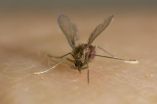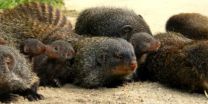(Press-News.org) Heroic worldwide conservation efforts have made great strides in saving China's endangered national treasure, the giant panda. Now, in China, there are over 65 giant panda reserves that have been established and three large breeding centers. But despite these efforts, just 1596 pandas remain in the wild.
Breeding programs in conservation centers and zoos hope to save the panda by improving genetic diversity, avoid inbreeding and ultimately, introduce pandas back to the wild. Just how are these high-profile programs doing so far?
In a new study appearing in the advanced online edition of Molecular Biology and Evolution, Fuwen Wei, et al., performed the most comprehensive genetic survey so far. They evaluated the diversity of 240 captive giant pandas from 4 Chinese breeding centers locations (Wolong, Chengdu, Louguantai, and the Beijing zoo account for 64 percent of the 341 pandas kept in captivity).
In good news for the breeding centers, high levels of genetic diversity and low levels of inbreeding were found in the captive populations, which indicate that the whole captive population is genetically healthy, and it is therefore unnecessary to capture more wild pandas for captive breeding. However, one center, the Louguantai population, faces a higher risk of inbreeding and requires urgent attention to correct, such as scientific-based breeding pairs.
Finally, the authors recommend that selection of captive pandas for reintroduction into the wild should consider their geographic origin, genetic background and genetic contribution. By combining the new molecular genetic data with pedigree data, the authors hope that panda research centers can successfully release pandas back into the wild.
INFORMATION:
Largest genetic survey to date shows major success of giant panda breeding programs
2014-07-23
ELSE PRESS RELEASES FROM THIS DATE:
The human parasite Leishmania is a probiotic for the fly that carries it
2014-07-23
The Leishmania parasite, which causes the human disease leishmaniasis, acts as a probiotic in the insect that transmits it to humans, protecting them from bacterial disease. Findings published in the open access journal Parasites and Vectors suggest that using bacterial controls to stop the spread of leishmaniasis could sometimes have the opposite effect to that intended, by benefiting flies carrying the parasite.
Around 12 million people are currently infected with leishmaniasis worldwide, mostly in South America, Africa and Asia. It is estimated to kill 20-50,000 people ...
Stress can make hard-working mongooses less likely to help in the future
2014-07-23
Researchers studying banded mongooses in Uganda have discovered that those who work hard to care for pups may be less likely to invest in future offspring in the same way due to elevated stress hormones.
Dr Jennifer Sanderson, from the University of Exeter, has been observing wild banded mongooses to understand why working hard makes them less likely to work hard in the future.
She discovered that when a banded mongoose invests heavily to care for mongoose pups, it experiences an increase in circulating stress hormones (or 'glucocorticoids'), and these high stress ...
New model helps explain how provisions promote or reduce wildlife disease
2014-07-23
Athens, Ga. – Scientists have long known that providing supplemental food for wildlife, or resource provisioning, can sometimes cause more harm than good. University of Georgia ecologists have developed a new mathematical model to tease apart the processes that help explain why. Their research, which has implications for public health and wildlife conservation, appears in the Royal Society journal Biology Letters.
Wildlife of many kinds are increasingly finding their meals in human environments, gathering at places like backyard bird feeders, landfills or farms that offer ...
In asthma, it's not just what you smell, but what you think you smell
2014-07-22
PHILADELPHIA (July 22, 2014) – New research from the Monell Center reveals that simply believing that an odor is potentially harmful can increase airway inflammation in asthmatics for at least 24 hours following exposure. The findings highlight the role that expectations can play in health-related outcomes.
"Asthmatics often are anxious about scents and fragrances. When we expect that an odor is harmful, our bodies react as if that odor is indeed harmful," said study lead author Cristina Jaén, PhD, a Monell physiologist. "Both patients and care providers need to understand ...
The dopamine transporter
2014-07-22
Recent published research in the Journal of Clinical Investigation demonstrates how changes in dopamine signaling and dopamine transporter function are linked to neurological and psychiatric diseases, including early-onset Parkinsonism and attention deficit hyperactivity disorder (ADHD).
"The present findings should provide a critical basis for further exploration of how dopamine dysfunction and altered dopamine transporter function contribute to brain disorders" said Michelle Sahai, a postdoctoral associate at the Weill Cornell Medical College of Cornell University, ...
Alaska frogs reach record lows in extreme temperature survival
2014-07-22
Freezing and thawing might not be good for the average steak, but it seems to help wood frogs each fall as they prepare to survive Alaska's winter cold.
"Alaska wood frogs spend more time freezing and thawing outside than a steak does in your freezer and the frog comes back to life in the spring in better shape than the steak," said Don Larson, University of Alaska Fairbanks graduate student and lead author on a recent paper demonstrating that freeze tolerance in Alaska wood frogs is more extreme than previously thought.
Although wood frogs are well-studied freeze-tolerant ...
Study examines presence of uterine cancers at the time of hysterectomy using morcellation
2014-07-22
Among women undergoing a minimally invasive hysterectomy using electric power morcellation, uterine cancers were present in 27 per 10,000 women at the time of the procedure, according to a study published by JAMA. There has been concern that this procedure, in which the uterus is fragmented into smaller pieces, may result in the spread of undetected malignancies.
Despite the commercial availability of electric power morcellators for 2 decades, accurate estimates of the prevalence of malignancy at the time of electric power morcellation (in this study referred to as morcellation) ...
The 92 percent clean plate club
2014-07-22
If you're a member of the Clean Plate Club – you eat pretty much everything you put on your plate – you're not alone! A new Cornell University study shows that the average adult eats 92% of whatever he or she puts on his or her plate. "If you put it on your plate, it's going into your stomach," says Brian Wansink Ph.D., author of the forthcoming book, Slim by Design, Professor of Marketing and Director of the Cornell Food and Brand Lab.
Wansink and co-author Katherine Abowd Johnson analyzed 1179 diners and concluded that we're a Clean Plate Planet. Although diners ...
Essays in English yield information about other languages
2014-07-22
Computer scientists at MIT and Israel's Technion have discovered an unexpected source of information about the world's languages: the habits of native speakers of those languages when writing in English.
The work could enable computers chewing through relatively accessible documents to approximate data that might take trained linguists months in the field to collect. But that data could in turn lead to better computational tools.
"These [linguistic] features that our system is learning are of course, on one hand, of nice theoretical interest for linguists," says Boris ...
NASA's Fermi finds a 'Transformer' pulsar
2014-07-22
VIDEO:
Zoom into an artist's rendering of AY Sextantis, a binary star system whose pulsar switched from radio emissions to high-energy gamma rays in 2013. This transition likely means the pulsar's...
Click here for more information.
In late June 2013, an exceptional binary containing a rapidly spinning neutron star underwent a dramatic change in behavior never before observed. The pulsar's radio beacon vanished, while at the same time the system brightened fivefold in gamma rays, ...





